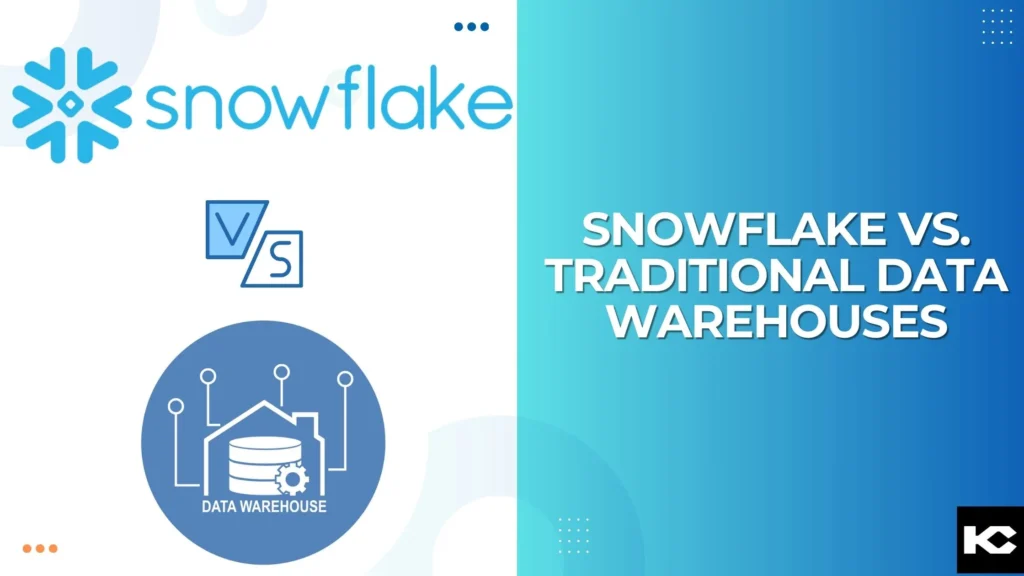Snowflake vs. Traditional Data Warehouses [2024]
In today’s data-driven world, organizations need a data warehousing solution that not only stores massive amounts of data but also enables quick, reliable, and scalable analytics. While traditional data warehouses have served businesses well over the years, modern cloud-based solutions like Snowflake are increasingly gaining favor. Snowflake offers unique features, such as multi-cloud support, automatic scalability, and advanced data-sharing capabilities, that set it apart from conventional data warehouses. Here, we’ll explore the key differences between Snowflake vs. traditional data warehouses to help you understand why many organizations are choosing Snowflake to drive their data strategies.
1. Architecture and Infrastructure
Traditional Data Warehouses: Built on on-premises hardware or early cloud-based models, traditional data warehouses often use rigid, monolithic architecture. They require substantial investment in infrastructure, with IT teams managing and scaling hardware manually. These systems are designed for fixed capacity, meaning if you need more storage or processing power, you must physically expand hardware, which can be costly and time-consuming.
Snowflake: Snowflake is a cloud-native data platform built on a multi-cluster, shared-data architecture. It operates entirely in the cloud, supporting multiple cloud providers (AWS, Azure, and Google Cloud). This architecture separates storage and compute, allowing users to scale each independently based on demand, which provides flexibility and cost efficiency. Snowflake automatically scales resources to match workloads, handling spikes in demand seamlessly without the need for physical hardware adjustments.
2. Scalability and Performance
Traditional Data Warehouses: Scaling in traditional data warehouses typically involves adding more physical resources (servers, storage, etc.) or performing costly upgrades. This can be slow and may cause interruptions, as organizations often need to pause operations to add capacity. Moreover, performance tuning and optimization require significant manual intervention from IT teams.
Snowflake: Snowflake’s separation of compute and storage makes it highly scalable, allowing users to allocate additional resources on demand without impacting ongoing workloads. Snowflake offers automatic performance optimization, using advanced techniques like data clustering, automatic query optimization, and caching. This means users can scale up for faster performance during peak times and scale down to save costs when demand is lower, all with minimal manual intervention.
3. Data Sharing and Collaboration
Traditional Data Warehouses: Data sharing in traditional environments is often limited, involving data replication or duplication, which creates delays and increases storage costs. External data sharing requires complex setups, such as FTP transfers, physical media sharing, or third-party software, which can hinder collaboration and introduce security risks.
Snowflake: Snowflake offers a built-in Data Sharing feature, which allows organizations to share live data securely with internal and external stakeholders in real time, without needing to move or copy data. Additionally, Snowflake’s Data Marketplace provides access to external datasets that can be integrated directly into the organization’s ecosystem, empowering businesses with valuable third-party data for analysis and decision-making.
4. Maintenance and Management
Traditional Data Warehouses: Traditional warehouses require extensive maintenance, including manual backups, indexing, and partitioning. IT teams must regularly monitor and optimize systems, handle software upgrades, and ensure data security. These tasks can be time-consuming and costly, with maintenance activities often interrupting access to data.
Snowflake: Snowflake’s cloud-native platform is fully managed, meaning it handles all maintenance tasks, such as patching, backups, and scaling, automatically. There’s no need for users to worry about system updates, infrastructure management, or performance tuning. Snowflake’s hands-free approach to management allows IT teams to focus on higher-value tasks, such as data strategy and analytics, instead of routine maintenance.
5. Security and Compliance
Traditional Data Warehouses: While traditional data warehouses can be secured, compliance can be challenging due to the lack of native cloud security features. Businesses must implement and monitor encryption, identity management, and access controls manually. Compliance with industry standards like HIPAA, GDPR, and SOC 2 can be a lengthy and complex process.
Snowflake: Security is a core feature of Snowflake, which is built with end-to-end encryption, data masking, multi-factor authentication, and other cloud-native security features. Snowflake complies with a wide range of industry standards, including HIPAA, GDPR, SOC 2, and PCI DSS, which simplifies regulatory compliance. It provides fine-grained access control, ensuring data security across teams and external partners, making it easier for companies to meet stringent regulatory requirements.
6. Cost Efficiency
Traditional Data Warehouses: Traditional data warehouses often come with significant upfront capital expenses, such as hardware purchases, installation, and ongoing maintenance. Over-provisioning resources to meet peak demand adds to these costs. Due to fixed storage and compute coupling, companies often end up paying for unused resources during non-peak periods.
Snowflake: Snowflake’s pay-as-you-go pricing model allows organizations to pay only for what they use, optimizing costs by scaling resources up and down as needed. Storage and compute costs are billed separately, which adds flexibility and enables companies to optimize usage for both storage and processing requirements. Additionally, Snowflake’s automated optimization features reduce the need for expensive manual interventions, lowering operational costs over time.
7. Data Diversity and Support for Semi-Structured Data
Traditional Data Warehouses: Traditional data warehouses are typically optimized for structured data in fixed schemas, making it difficult to handle semi-structured data (like JSON, Avro, or XML). This can limit the ability of traditional warehouses to support diverse data sources and adapt to modern data needs.
Snowflake: Snowflake supports both structured and semi-structured data natively, enabling users to load and analyze diverse data types without the need for data transformations. Using its VARIANT data type, Snowflake seamlessly integrates JSON, Parquet, and other semi-structured data formats, allowing users to ingest and query data in its native format. This makes Snowflake well-suited for modern analytics environments that rely on data variety and flexibility.
Conclusion: Choosing the Right Solution for Your Business Snowflake vs. Traditional Data Warehouses
While traditional data warehouses have been foundational to data management, Snowflake offers a flexible, scalable, and efficient alternative that meets the needs of modern businesses. By decoupling storage and compute, automating maintenance, enabling seamless data sharing, and supporting both structured and semi-structured data, Snowflake empowers organizations to drive deeper insights and adapt to rapidly changing data landscapes.
Snowflake’s advantages in cost efficiency, scalability, and cloud-native architecture make it a compelling choice for companies seeking a future-proof solution. However, organizations should consider their specific needs, existing infrastructure, and long-term data strategies when choosing between Snowflake vs. traditional data warehouses. In a world where data is an invaluable asset, having the right platform can make all the difference in achieving data-driven success.
Kizzy Consulting is a leading provider of Salesforce consulting and Snowflake partner in the USA and Australia. We specialize in helping businesses leverage AI and other advanced technologies to optimize their CRM processes and achieve their strategic goals. Contact us at [email protected] to learn more about how we can support your Salesforce journey.




